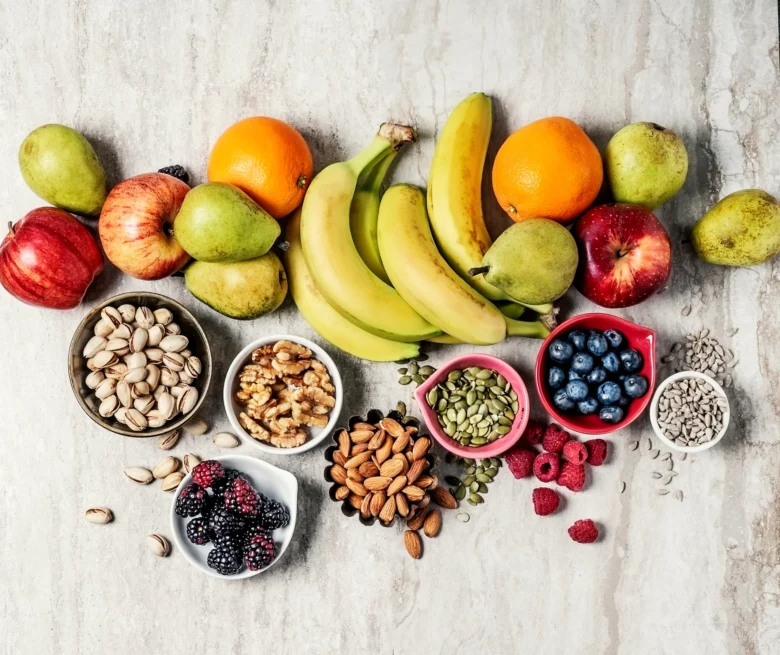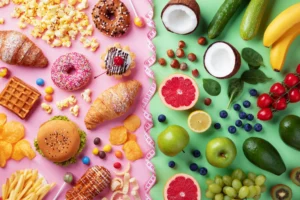Clean living isn’t about following strict rules about what you can and can’t eat, but about choosing whole, raw foods that are good for your health. Clean living is based on using natural ingredients that retain their original flavor and are prepared with care. It tells you to avoid the processed snacks, sugary drinks, and fake ingredients in the middle of the grocery store and to shop at the edge of the store where fresh fruits and vegetables, lean meats, and dairy are stored. By focusing on simple, nutritious foods, you can reduce your exposure to dangerous ingredients while giving your body the energy it needs to function optimally.
Choose Whole Fruits and Vegetables
Fruits and vegetables are the cornerstone of any healthy eating plan. These foods are rich in vitamins, minerals, dietary fiber, and antioxidants. They all help strengthen the immune system, improve digestion, and enhance overall health. To eat clean, fill half your plate at every meal with fruits and vegetables of various colors. Leafy greens, spicy vegetables, nuts, and colorful dishes are all good for you. Eating fruits and vegetables in their natural state—steamed, boiled, baked, or raw—helps preserve nutrients. Choose organic or local produce whenever possible to avoid pesticide residues, and enjoy a variety of delicious foods all year round.
Choose lean proteins
Protein is essential for muscle building, hormone secretion, and feeling full. A healthy lifestyle encourages eating less processed, lean protein sources. Eggs, chicken and turkey, salmon and cod, and plant products like beans, chickpeas, and tofu are all good choices. In addition, it’s best to eat pasture-raised or grass-fed red meats, as the fats in these products tend to be healthier. Avoid processed meats like bacon, sausage, and sandwiches, as they often contain high levels of salt, artificial flavors, and preservatives.
Add good fats to your diet
There are many types of fats. Healthy eating helps you eat healthy fats that are good for your brain, hormone balance, and nutrient absorption. Avocados, nuts and seeds, olive oil, and fatty fish are all good sources of fat. Many canned foods contain trans fats and highly processed vegetable oils, which should be replaced with these fats. Healthy fats are high in calories, but they help you feel full, making it easier to follow a healthy diet. Instead of loading your salad with healthy fats, mix them into drinks or stir-fry vegetables.
Choose whole grains over refined carbohydrates
Whole grains provide energy, fiber, and important nutrients that refined carbohydrates do not. Instead of white bread, pasta, and rice, choose whole grains such as quinoa, brown rice, oats, barley, and whole wheat products. These foods are broken down more slowly, which helps keep your blood sugar levels stable and gives you energy for longer. Always read labels carefully when shopping and look for products that list “whole grain” as the first ingredient, rather than “enriched” or “refined.” If you are sensitive to gluten, try buckwheat, quinoa, or oats, which are certified gluten-free.
Avoid highly processed foods
Most highly processed foods are high in sugar, bad fats, salt, and fake ingredients. These include sweetened breakfast cereals, ready-made snacks, frozen meals, and fast foods. Often marketed as “convenient,” regular consumption of these highly processed foods can harm your health by causing inflammation, weight gain, and long-term problems. If you eat healthy, eat these foods only as snacks, not as a regular meal. Try popcorn or chopped veggies with hummus instead of a bag of chips.
Avoid sweeteners and extra sugar
Unnaturally occurring sugars can be found in yogurt, sauces, salads, and even bread. A diet high in sugar can cause metabolic problems, dental problems, and energy dips. To avoid these problems, read nutrition labels and ingredient lists carefully. Choose foods with less added sugar. If you have a sweet tooth, eat whole fruit or use a small amount of natural sweeteners, such as honey or pure maple syrup. Over time, your taste buds will adjust and you will have fewer sweet cravings.
Avoid preservatives and artificial ingredients
Artificial flavors, colors, and chemicals can extend the shelf life of food, but they are Plan your meals weekly with whole foods. List the healthy foods you want to use ahead of time. Prep your veggies, cook your grains all at once, and freeze your lean proteins. Keep healthy snacks like nuts, fruit, and hard-boiled eggs on hand so you don’t reach for less healthy options when you’re hungry.
How to Sustain Long-Term Success
Instead of following a short-term diet, adopt a healthy lifestyle and make it a permanent habit. Eat a balanced diet and give yourself time. Treat yourself to something tasty every now and then to stave off hunger. Keep things interesting by trying new recipes and foods regularly. Involve your family and friends in your quest for a support network. Over time, eating healthy will feel less like a job and more like a fulfilling lifestyle. You’ll have more energy, be healthier, and maybe even control your weight.
In short, nourish your body and make eating easier
Eating clean is all about keeping it simple and paying attention to the details. By choosing nutrient-dense, whole foods and limiting processed foods, you can lay the foundation for long-term health and wellness. Remember, growth is the goal, not perfection. Every healthy, balanced meal you cook is a step toward better health. Embrace the beginner’s mentality, experiment with new ingredients, and enjoy discovering the deliciousness of real, simple food.




